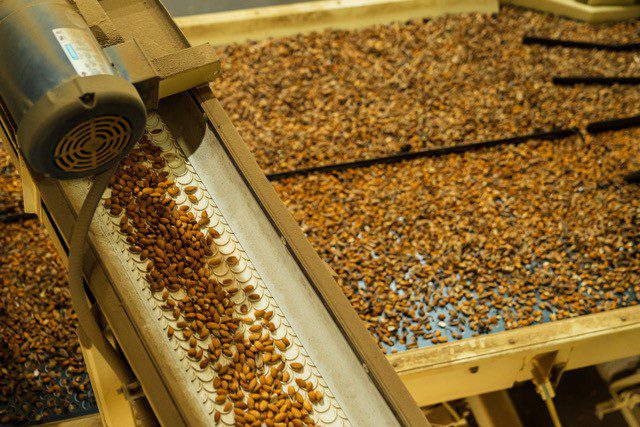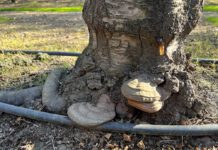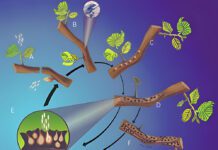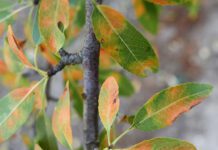Climate that promotes growth of fungi and insect feeding that provides openings for fungal infection are major drivers of aflatoxin contamination in almond and pistachio.
According to Safe Food Alliance, aflatoxins are chemical compounds created by fungi or mold. Aflatoxins are toxic and carcinogenic and are produced by two species of Aspergillus fungi: flavus and parasiticus. Pistachio and almond growers can take steps to prevent growth of Aspergillus fungi in their orchards and control the insect pests that increase the risk of crop contamination. Processors and handlers have the responsibility of removing contaminated nuts from shipments.
Josette Lewis, chief scientific officer for Almond Board of California, said aflatoxin contamination in almonds is a serious industry concern and an expensive problem if found in a shipment of raw almonds destined for export. The Pre-Export Check (PEC) program, which is voluntary, is a tool to manage costs and uncertainty of aflatoxin before export. The program provides an aflatoxin analysis certificate if the shipment meets the criteria established by the importing country. This program works well for shipments to the EU, but the almond Board is working to get agreement with Japan to recognize PEC. Rejected shipments in Japan must be returned to California.
A similar program for pistachio exports, The Pistachio Export Aflatoxin Reporting (PEAR) program, was initiated as a combined effort between industry professionals and regulatory officials in the early 2000s. PEAR includes setting a shipping tolerance that equals or is more restrictive than the EU aflatoxin tolerance depending on crop year, sampling by the pistachio handler, testing in USDA-approved analytical laboratories and auditing of the shipping process by USDA-Specialty Crop Inspection.
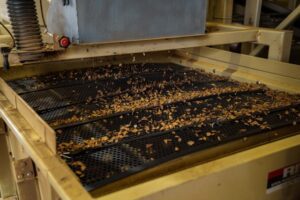
Insect Damage Link
Lewis noted aflatoxin contamination in almond orchards “is not a problem every year in every orchard.” While more insect damage is linked to aflatoxin, it is difficult to predict contamination levels.
Last year’s harvest, which had a higher percent of insect damage, still had no increase in the number of export rejections, Lewis said, a testament to the work of handlers to remove damaged nuts and to the success of PEC.
Almond handlers pay growers on a scale based on quality, incentivizing growers with lower levels of damaged kernels, Lewis said.
Lower-quality almonds have higher processing costs and carry a higher risk of contamination. Sorting out damaged kernels also reduces risk of a shipment testing above the limits for aflatoxin.
Crop contamination percentages have been low as long as growers perform good orchard sanitation, decreasing the risk of aflatoxin contamination, Mel Machado of Blue Diamond Growers said. Normal nuts with good seals have little risk of contamination, but he noted with the spread of the Carpophilus beetle in almond orchards, that could make a difference as they can chew into shells.
Reducing Potential Risk
Researchers note that reducing the potential for contamination begins in the orchard. Delaying harvest after hull or shell split allows insects to cause more damage and elevates the risk of aflatoxin contamination. Climate, drought stress and high populations of navel orangeworm (NOW) are correlated with insect damage and thus can elevate aflatoxin risk. Other prevention strategies include cleaning handling equipment to avoid cross-contamination. Using surface disinfectants like ethanol, hydrogen peroxide, acetic acid and peracetic acid can be used to reduce mold.
Warm weather and the humidity that comes with irrigation present ideal growing conditions for Aspergillis fungi in orchards. Those conditions can be compounded by delayed harvests and poor orchard sanitation, allowing high levels of pest pressure. NOW has taken the blame for creating the physical damage that leaves openings for aflatoxin contamination on nuts. Carpophilus beetle is also causing kernel damage that opens kernel surfaces to aflatoxin contamination.
Rejection of almond and pistachio shipments for direct consumption by export markets and risk to human health led the almond and pistachio industries to take potential aflatoxin contamination of nuts seriously. Biocontrol agents were developed and testing protocols for exports were established.
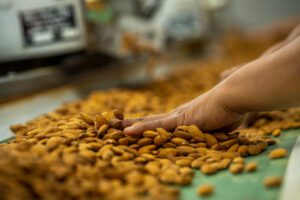
In research funded by the California Pistachio Research Board, UC Plant Pathologist Themis Michailides said that aflatoxin contamination is unpredictable and is linked to NOW population in the orchard. The two biocontrol agents registered for almond and pistachio work by displacement of the toxigenic Aspergillus isolates, the fungi-causing molds and aflatoxin by the atoxigenic strains of the mold. In his trials, an 80% displacement will be considered successful. The average displacement for pistachios in California has been around 70%, he noted.
The two biocontrol products, AF36 PrevailTM and Afla-GuardTM GR, are used to outcompete the Aspergillus fungi in orchard soils. Since the registration of AF36 in 2012 and Afla-Guard in 2021, many almond and pistachio growers who adopted these biocontrol tools minimized contamination. Michailides noted adoption of biocontrol is higher in pistachios than almonds.
AF36 Prevail and Afla-Guard GR are applied in almond and pistachio orchards from late May through early July.
Results from a 2022 trial showed the percentage of fungi displacement was significantly different depending on the time of applications and the product used. Michailides said the use of products sporulating at higher rates under low temperatures and soil moistures earlier might help increase the efficacy of the atoxigenic A. flavus strain. Displacement data of toxigenic strains by AF36 and Afla-Guard at different times indicate the Afla-Guard might be more efficient in earlier applications as it sporulates at lower temperatures and moisture levels. Starting with Afla-Guard and finishing with AF36 might be a strategy to use, he said. The populations of either product decline after one year since application; therefore, the application of the biocontrol products needs to be done annually.
Michailides said further studies on prevention of aflatoxin contamination by either product are in progress.

Cecilia Parsons | Associate Editor
Cecilia Parsons has lived in the Central Valley community of Ducor since 1976, covering agriculture for numerous agricultural publications over the years. She has found and nurtured many wonderful and helpful contacts in the ag community, including the UCCE advisors, allowing for news coverage that focuses on the basics of food production.
She is always on the search for new ag topics that can help growers and processors in the San Joaquin Valley improve their bottom line.
In her free time, Cecilia rides her horse, Holly in ranch versatility shows and raises registered Shetland sheep which she exhibits at county and state fairs during the summer.







